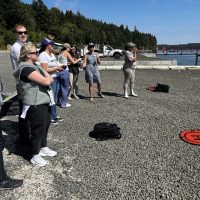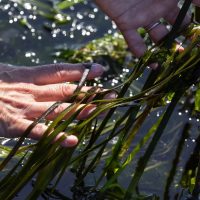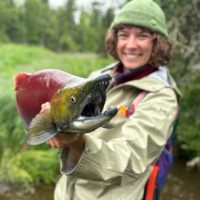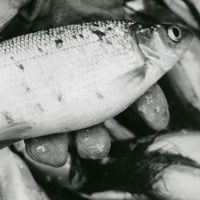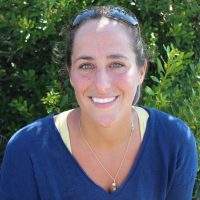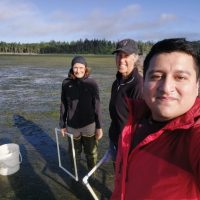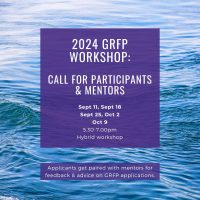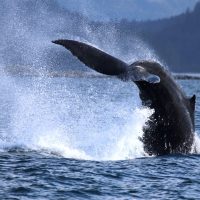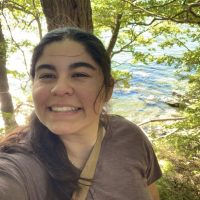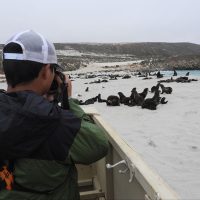Filter Results
Putting on a show: SAFS drone program demonstrates research for congressional staff
On August 16, congressional staff from the State of Washington gathered for a drone demonstration, led by the Marine Landscape and Ecology Lab (MLEL), based at the University of Washington School of Aquatic and Fishery Sciences.
Read moreUW researchers discover eelgrass superpower in Puget Sound
Eelgrass meadows are among the most productive and ecologically important places in Puget Sound. Already highly valued as nurseries for sea life, researchers including SAFS Affiliate Faculty, Drew Harvell, have discovered a new eelgrass superpower, as living urban systems that reduce human pathogens in seafood by as much as 65%.
Read moreThe return of the sockeye: a summer with the Alaska Salmon Program
You may be familiar with the Alaska Salmon Program and its critical role in producing knowledge for managing and conserving regional ecosystems and their fisheries. But we’re doing a deeper dive into the role of students in the program, the opportunities for immersive learning, and the bonding experience with both fellow students and instructors during their time in Alaska.
Read moreThe globalization of the aquatic food trade
In an increasingly globalized world, aquatic foods have followed the same trend. Seafood is one of the most highly traded foods in the world and is a critical resource for human nutrition, livelihoods, and revenue. But despite this globalization trend, researchers have revealed that the basic characteristics of aquatic food trade remain largely unknown.
Read moreWelcome Carter Smith, coastal ecologist and SAFS newest faculty member
On 16 September 2024, the newest faculty member will join SAFS, Assistant Professor Carter Smith. Carter is an interdisciplinary coastal ecologist whose interests lie at the intersection of multiple disciplines including community ecology, conservation and restoration science, and coupled human natural systems research.
Read moreHow do our sea-meadows grow?
The WSG-funded research informs the future of eelgrass restoration in Washington, and the study is headed by UW Professors Kerry Naish (SAFS) and Jennifer Ruesink (Biology), as well as SAFS doctoral student Bryan Briones Ortiz. Their research first looked at the baseline genetic structure of the eelgrass population in Washington.
Read moreCall for mentors and participants in GRFP workshop
Call for participants and mentors for the 2024 GRFP workshop. The National Science Foundation’s Graduate Research Fellowship Program (GRFP) offers 3 years of support for graduate students, and hybrid workshops will be held during September and October to pair participants with mentors to offer guidance and advice for the application.
Read moreRapid increase rates in large whale populations continue until they near carrying capacity
In a new study challenging conventional thinking about how populations of large baleen whales recover from whaling, researchers have revealed that populations continue increasing rapidly for a wide range of recovery levels, only slowing once approaching pre-whaling levels.
Read moreNewly graduated SAFS master’s student chosen as 2024 WSG Keystone Fellow
Recent graduate of the SAFS master’s program, Jezella Peraza, has been chosen as the 2024 Washington Sea Grant (WSG) Keystone Fellow. As the 2024 WSG Keystone Fellow, Jezella will work with the Seattle Aquarium on an integrated conservation effort for pinto abalone. In collaboration with Indigenous Peoples and local communities, Jezella will help shape and implement engagement strategies to support pinto abalone recovery and honor cultural connections.
Read moreReal-world research as an undergraduate: studying pinnipeds on San Miguel Island with NOAA
In the most recent cohort of University of Washington (UW) students participating in the NOAA Marine Mammal Lab internship program organized through SAFS, Chris Moon spent the summer of 2024 working with Dr. Tony Orr from NOAA Alaska Fisheries Science Center (AFSC), studying northern fur seals and California sea lions on San Miguel Island, California.
Read more